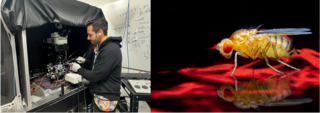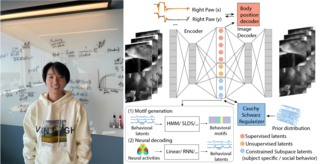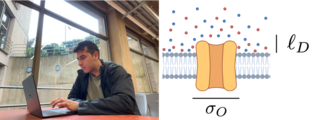How do neurons receive, integrate, interpret, and send information? Labs studying computational neuroscience try to develop computational models of these complex neuronal networks. Researchers studying sensory neuroscience aim to understand how organisms sense and interpret information from the outside environment. Scientists working in the area of neural computation investigate how information is processed by networks of neurons in the brain.
Featured Research
Motion detection in olfaction: how the fly brain encodes odor motion
Gustavo Madeira Santana ‘26
he/him
Interdepartmental Neuroscience Program (Emonet Lab)

Understanding the Mapping Between Neural Activity and Behavior
Daiyao Yi ‘26
she/her
Electrical Engineering (Saxena Lab)

How the physics of noise determines the sensitivity of ion channels
Jose Betancourt ‘29
he/him
Physics (Machta and Lynn Labs)

Faculty
-
Damon Clark
Professor; Molecular, Cellular & Developmental Biology, Physics, and NeuroscienceResearch Interests: Neuronal computation -
Thierry Emonet
Professor; Molecular, Cellular & Developmental Biology and PhysicsResearch Interests: We combine theory and experiments to understand the computations organisms perform to navigate chemical environments. Bacteria: we analyze information processing in individual cells, the molecular basis of individuality, and how biological diversity benefits populations. Fruit flies: we examine how insects perform goal oriented olfactory navigation, and how they adapt decision-making strategies in real time as odor signal statistics and environmental conditions change -
Joe Howard
Professor; Molecular Biophysics & Biochemistry and PhysicsResearch Interests: Microtubules and molecular motors. Branching morphogenesis of neurons. Motility of cilia and flagella. Nerve nets. -
Anthony Koleske
Professor; Molecular Biophysics & BiochemistryResearch Interests: Cellular shape and motility; biochemical dissection of signaling pathways; regulation of normal and cancer cell migration; and formation, function and stability of neural connections -
Liang Liang
Assistant Professor; NeuroscienceResearch Interests: Synaptic and neural circuit mechanisms underlying visual information processing; combining recording of neural activity in awake behaving animals, image processing, and computational modeling -
Christopher Lynn
Assistant Professor; PhysicsResearch Interests: Understanding how structure and function emerge in complex living systems, particularly the brain. -
Harry McNamara
Assistant Professor; Molecular, Cellular & Developmental BiologyResearch Interests: Synthetic developmental biology: measuring and controlling stem cells to understand how they self-organize multicellular structures in vitro (organoids, embryoids) -
Sathish Ramakrishnan
Assistant Professor; PathologyResearch Interests: Our lab develops cutting-edge lab-on-chip and nanotechnology tools to decode cellular secretion and communication, applying these insights to design transformative therapeutic strategies for aging, diabetes, and neurodegeneration -
Shreya Saxena
Assistant Professor; Biomedical EngineeringResearch Interests: Investigating topics at the interface of statistical inference, recurrent neural networks, control theory, and neuroscience -
Steven Zucker
Professor; Computer Science and Biomedical EngineeringResearch Interests: Computational vision, machine learning of neuroscience data, manifold inference and neural circuits.









